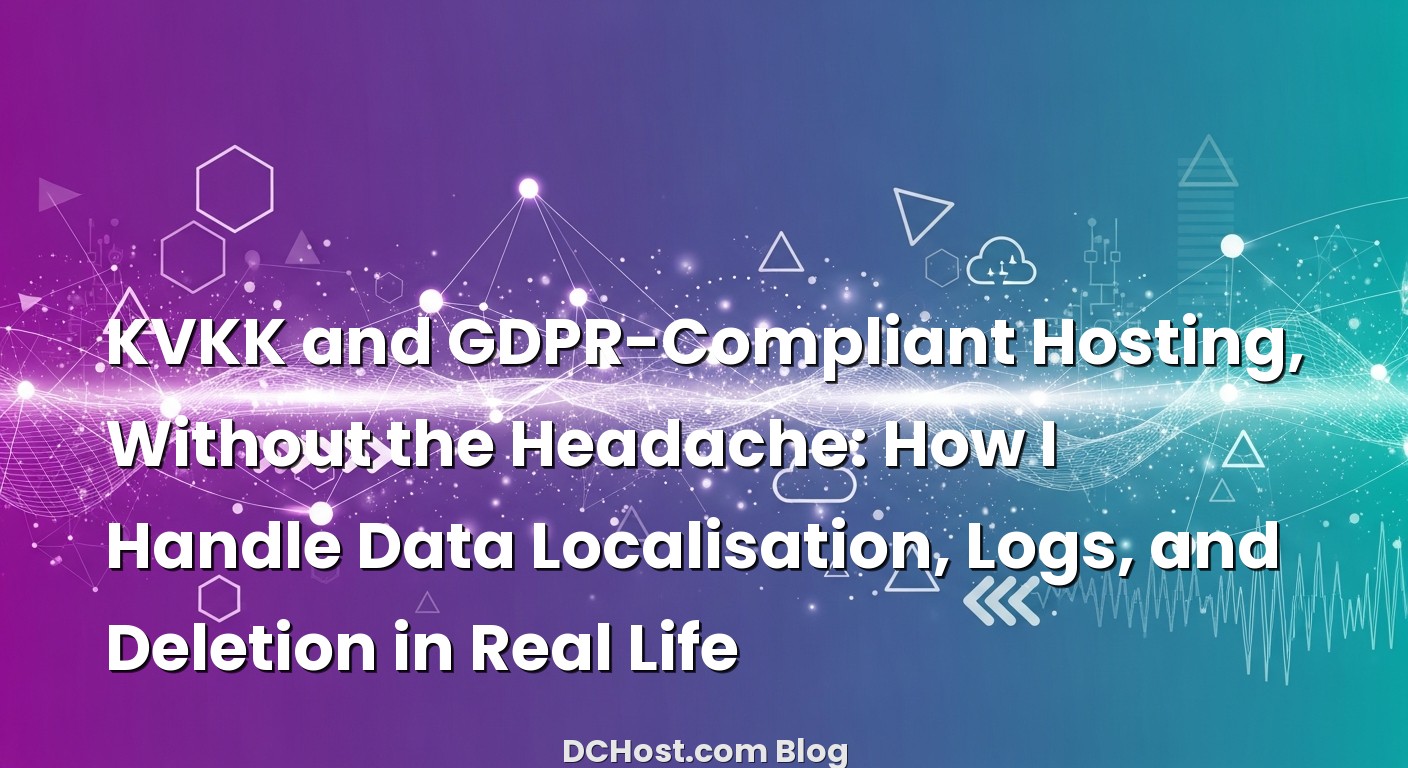So there I was, coffee cooling on the desk, staring at a ticket from a client who’d just landed their first big enterprise deal. “We need to be KVKK and GDPR compliant by next month. Can our hosting handle it?” I could hear the mix of excitement and panic in their voice. If you’ve ever been in that spot—where legal letters meet server dashboards—you know the feeling. You’re wondering where your data actually lives, whether your logs are storing too much, and how on earth you delete data that’s already buried in backups. It can feel like trying to organize a cluttered garage while the neighbors are watching.
Here’s the thing: compliance isn’t about chasing obscure checkboxes. It’s about building a hosting setup that respects people’s data and has predictable rules for how you store, monitor, and clean things up. In this post, I’ll walk you through how I approach KVKK and GDPR in hosting, with a focus on three practical pillars: data localisation, logging, and deletion policies. I’ll share the way I explain it to clients, the shortcuts that save time, and the little gotchas that can trip you up. No stiff legalese, just what works in the real world.
İçindekiler
- 1 What KVKK and GDPR Actually Expect from Your Hosting
- 2 Data Localisation: Where Your Data Sleeps Matters
- 3 Privacy-Friendly Logging: Keep the Lights On Without Storing the Keys
- 4 Deletion and Retention Policies: Making the Right to Be Forgotten Real
- 5 Proving Compliance: DPIAs, Audits, and the Paper Trail That Saves Time
- 6 Practical Hosting Setups I Like for Compliance
- 7 A Friendly Checklist You Can Actually Use
- 8 Wrap-Up: Turn Compliance from a Fire Drill into a Habit
What KVKK and GDPR Actually Expect from Your Hosting
I like to think of KVKK and GDPR as two friendly but strict neighbors who care about the same thing: people having control over their personal data. GDPR covers the EU and EEA, and KVKK covers Turkey. The vocabulary is a little different, the paperwork takes different routes, but the spirit is similar. Keep data safe. Be clear about what you’re doing. Don’t keep information longer than you need. And when someone asks you to delete their data or hand it over, you should be ready.
In hosting terms, there are a few roles that matter. There’s the data controller—that’s usually you or your company—who decides why and how personal data is processed. Then there’s the data processor—your hosting provider—who handles data on your behalf. If the processor is outside your jurisdiction, or if your data is moving across borders, that’s where localisation and transfer rules kick in. And that’s where panic tends to start, because the internet doesn’t care about borders, even if laws do.
Here’s my simple litmus test. If you can answer “where your data sleeps,” “who can see it,” “how long it sticks around,” and “how it gets deleted,” you’re already ahead. The rest—contracts, documentation, technical checklists—flows from those answers. You’ll want a proper data processing agreement with your host, clear responsibilities, and a map of your data flows. Not scary, just systematic. And if you want to go deeper, there’s helpful official guidance from both the Turkish Data Protection Authority (KVKK) and the European Commission’s GDPR portal that can orient you without turning you into a lawyer.
Data Localisation: Where Your Data Sleeps Matters
One of my clients once asked, “If my site is hosted in Frankfurt, does that mean I’m safe for GDPR? And what about Turkish users and KVKK?” Great question. Think of data localisation like choosing the neighborhood for your data’s home. If most of your users are in Turkey, keeping the primary dataset in a Turkish data center can simplify compliance conversations and make latency better. If you serve EU users, hosting in the EU is a smart default because you avoid some transfer complexities. When you operate across both, you’ll want to be intentional about where the source of truth lives and how copies move around.
Under GDPR, transferring personal data outside the EEA requires appropriate safeguards—things like standard contractual clauses or an adequacy decision. That’s not a showstopper; it’s a framework. With KVKK, cross-border transfers also have conditions, and approvals can be more procedural. In practice, many teams keep primary data in-region to keep things simpler and then use controlled, documented pathways for anything that leaves. I’ve worked with setups where the main database sits in Istanbul, with a read-only replica in an EU region behind strict access rules, and a separate analytics stream that’s fully anonymized.
Backups add an extra wrinkle. If you’ve ever wondered whether backups count for localisation, you’re not alone. The short answer is yes, they matter. If the data is personal and it lives somewhere, it’s in scope. That doesn’t mean you can’t back up across regions; it means you should document where backups sit, how they’re encrypted, and how you’ll handle deletion requests. If you’re designing a multi-region layout, decide upfront what’s allowed to cross borders and what must stay. I like to write this in plain language and keep it with the runbook—makes audits and client questions a lot less painful.
One more thing: content delivery networks and third-party services can quietly move data around for performance or filtering. Be mindful of your CDN’s logging behavior and the location of their edges. If a service inserts cookies, captures IP addresses, or processes form submissions, that’s personal data processing. You don’t need to run from CDNs; just know what they log, where, and for how long, and make sure your privacy notice reflects the setup. The European Data Protection Board publishes transfer guidance that’s useful for reality-checking these decisions.
How I choose regions in practice
In my experience, I start by mapping users and the legal footprint: Turkish audience, EU audience, or both. Then I pick a primary region that aligns with the bulk of users and the stricter obligations. If both are equally important, I’ve had success running dual primary stacks—one in Turkey, one in the EU—with separate databases and a carefully controlled sync for non-personal or anonymized data. It’s a bit more effort, but it keeps the transfer math clean and reduces overnight surprises when rules tighten.
Privacy-Friendly Logging: Keep the Lights On Without Storing the Keys
Logs are like the black box on an airplane—you don’t think about them until something goes wrong. But with KVKK and GDPR, logs deserve attention upfront. Because here’s the twist: IP addresses, device identifiers, and even certain error details can be personal data. The goal isn’t to stop logging. The goal is to log smartly: enough to debug, detect threats, and meet audit needs, without collecting every piece of personal information you can possibly grab.
When I set up logging policies, I start with purpose. What do we need logs for? Usually it’s three things: reliability, security, and compliance. For reliability, you want to see request paths, timing, and error codes. For security, you want authentication events, access attempts, and integrity alerts. For compliance, you need audit trails that show who accessed what and when. Notice what’s missing from that list: full query strings with sensitive data, raw user input, and long-term storage of IPs. That stuff can become a risk if it leaks.
On web servers, I trim logging formats so they avoid sensitive headers and redact tokens. I also anonymize or truncate IP addresses when it won’t hinder security work—hashing, partial masking, or using a short-lived pseudonymous token often strikes the right balance. On load balancers and proxies, I keep only the fields we genuinely need to troubleshoot issues. And on application logs, I’m careful to avoid dumping stack traces that include personal details. There’s nothing like a “Password reset for [email] failed” message sitting in plaintext logs to ruin your day later.
Retention is where you draw the line in the sand. I like to set default windows—say, 30 days for verbose application logs, 90 days for access logs, and a bit longer for security logs if there’s a compliance reason. The exact numbers depend on your industry, but the discipline matters more than the digits. Shorter retention reduces exposure. If there’s a reason to extend retention, document it and circle back periodically to see if it still applies. Automatic log rotation, immutability for security logs, and encryption at rest are part of the routine. And of course, strict access controls; only the folks who need logs get them, and the access itself is logged.
Centralizing logs helps when audits happen. A lightweight SIEM or even a well-organized log aggregation system means you can answer questions quickly: who accessed admin at 03:17, how many failed logins triggered the lockout, when did the WAF block that IP range. Time synchronization across servers is one of those boring details that pays off when minutes matter. And if you ever handle a breach response, having logs that are reliable, tidy, and limited in sensitive data saves you from a second crisis during the first one.
Web, database, and security tools—what I keep in mind
On the web layer, I strip query parameters that include personal data from standard access logs and rely on targeted debug logs during incidents. On databases, I avoid logging full row contents; I focus on slow queries and schema errors. For security tools like intrusion detection and WAFs, I store enough detail to understand an attack pattern without keeping payloads longer than necessary. And if I must keep payloads briefly for analysis, I store them separately with tight retention and access limits. It’s not about perfection; it’s about balancing usefulness with privacy.
Deletion and Retention Policies: Making the Right to Be Forgotten Real
Let’s talk about the least glamorous topic that causes the biggest headaches: deleting data. I remember a startup founder who swore they were deleting customer data “instantly.” We traced the data and discovered it was disappearing from the main database but living a whole extra life in three backup tiers, analytics snapshots, and a staging copy. That’s normal. Data scatters. The trick is to make deletion a process, not a wish.
I always start with a data inventory. Nothing fancy—just a clear list of what personal data you collect, where it’s stored, who has access, and how long you plan to keep it. Then I define retention by category. Maybe transactional data needs to stick around for financial or legal reasons for a while; maybe support chats can be shorter. What matters is that you decide. You’re allowed to have practical retention periods as long as they’re justifiable and documented.
For operational deletion, I like a two-step path. First, soft deletion in the app so the user no longer sees their data and it’s excluded from active processing. Second, hard deletion from primary storage on a schedule that’s short and predictable. When it comes to backups, the approach changes. You rarely surgical-delete a single user from a snapshot; instead, you set backup retention so older snapshots age out. That’s acceptable, as long as you stop using the data for any purpose and ensure it disappears when the retention window closes. If you need a refresher on building a sane backup framework, I’ve written a friendly guide to the 3-2-1 backup strategy and automating backups on cPanel, Plesk, and VPS that pairs nicely with deletion policies.
Verification is the part people skip. When a deletion request comes in, I want to be able to prove that the data is gone from primary systems, queued for removal from caches, and set to expire from backups according to retention. I keep a simple checklist and record on the ticket the exact time the deletion job ran, which systems were touched, and the expected final backup expiry date. If we anonymize instead of fully delete—say, for analytics—we document how that anonymization is irreversible.
One more practical note: secure wiping. For SSD-backed systems and cloud storage, you often rely on cryptographic erasure rather than overwriting blocks. Encrypt data at rest with keys scoped per environment, rotate keys when appropriate, and if you decommission disks, follow your provider’s destruction process. You don’t have to reinvent this; you just need to know how it works in your stack and be able to explain it in plain words if asked.
Handling special cases without losing your mind
Sometimes a user has open invoices, or a fraud investigation is underway, or you’re subject to a legal hold. That’s life. In those cases, I mark the data as locked for a specific reason and restrict access. The key is that it’s intentional. You’re not “keeping it just in case.” You have a clear purpose and a clear end date. And when the hold lifts, the deletion flow continues without manual heroics.
Proving Compliance: DPIAs, Audits, and the Paper Trail That Saves Time
Everyone loves servers until the first audit. Then you realize the quiet hero is your documentation. Don’t worry, I’m not talking about 90-page PDFs nobody reads. I mean a tight set of living docs and logs that show you know your system. In the KVKK and GDPR world, that looks like a simple record of processing activities, a data flow diagram, a list of processors and sub-processors, and your retention schedule.
If you introduce a high-risk processing activity—say, large-scale profiling—you might need a Data Protection Impact Assessment. Even when it’s not mandatory, doing a mini-DPIA is useful. You list the risks, the mitigations, and the residual issues you accept. It’s less about creating a binder and more about proving you thought things through. When I walk a client through this, we keep the language human: what data comes in, what we do with it, who sees it, how it leaves, and how we protect it.
Incident response is part of this story. You’ll want a clear playbook that says who does what when a breach is suspected, how you contain it, how you notify affected parties if needed, and how you preserve logs. The irony is that privacy-friendly logging actually makes incidents easier to handle, because you’re not drowning in sensitive details that complicate containment.
Your hosting provider’s role shows up here, too. Make sure you know how they handle security incidents, what their SLAs look like for notifications, and where your responsibilities start and end. If they offer features like DDoS protection, WAFs, managed backups, or regional replication, fold those into your controls and document the settings you’ve chosen. The goal is to be able to answer “How do you know?” with something better than “Because I think so.”
Practical Hosting Setups I Like for Compliance
Over the years, I’ve found a few setups that cover most use cases without making you feel like you’re juggling chainsaws. For teams focused on Turkey-first operations, a primary stack in a Turkish data center works well, with encryption at rest, a measured logging policy, and a clean backup and deletion plan. If you’ve got a European footprint, mirror that idea in the EU and think carefully about whether you really need cross-region replication of personal data. Often, you don’t.
I also like to separate “hot” personal data from “cold” operational data. Customer profiles and orders live in the primary database, and we keep them tight. Aggregated analytics, de-identified logs, and performance metrics live in separate stores. That way, your localisation and deletion policies are easier to apply, because you don’t have to fish personal data out of a sea of telemetry every time someone asks for erasure.
For keys and secrets, use managed key management or a well-audited vault solution and restrict access by role. Treat staging and development as real environments: either anonymize or use synthetic data. I’ve seen too many teams leak personal data into staging and then forget it exists. If you must use real data in lower environments for debugging, set a very short retention timer and a deletion job that doesn’t rely on memory or goodwill.
DDoS protection, WAFs, and good old SSL/TLS are table stakes, but for compliance they also help define your controls. Proper TLS settings protect data in transit, WAFs reduce exposure to injection attempts, and DDoS controls preserve availability—which is part of integrity and confidentiality. Pair that with a firewall policy that defaults to deny and opens only what you truly need. Minimalism is a security feature.
A note on vendor choices without naming names
You don’t need a “compliance-branded” hosting plan to get this right. What you need is clarity: where the provider’s data centers are, what logging they do by default, how backups are stored and encrypted, and how they handle deletions on deprovisioning. Ask how they support cross-border transfers, whether they have EU and Turkish regions, and if they’ll sign the right processing agreements. Most solid providers have these answers ready. If not, that’s your signal.
A Friendly Checklist You Can Actually Use
Let’s keep this simple and conversational. Start by mapping your data. Where do you collect it, which services touch it, and what’s the minimum you truly need? Next, pick your primary region deliberately and document why. Then shape your logs so they’re useful without being nosy, and give them a retirement date. Build deletion as a routine, not a drama. And finally, keep a short set of documents that prove you have your act together: data flows, retention schedule, processor list, and incident plan. That’s it. No wizardry.
If you want to sanity-check your cross-border reasoning, spend a few minutes with the official pages from the KVKK authority and the European Commission, and keep an eye on transfer guidance from the EDPB. Don’t worry about memorizing every clause; just make sure your hosting setup matches the spirit and you can explain it in plain words.
Wrap-Up: Turn Compliance from a Fire Drill into a Habit
When I think back to that client with the tight deadline, what saved us wasn’t a magic tool. It was simple, honest answers and a tidy setup. We picked a primary region that made sense, trimmed the logs, tightened access, and wrote down how deletion worked—including backups. Nothing flashy. But when the enterprise partner asked questions, we had calm, clear responses. That’s the feeling I want for you: confident, not defensive.
If you take one thing from this, let it be this: compliance isn’t a finish line you cross once. It’s a habit you bake into hosting—where data lives, what you log, and how you let go. Start with the basics, adjust as you learn, and keep your documentation just good enough to help future-you. And if this sparked ideas or you want me to break down a specific setup, I’m always up for another coffee-fueled deep dive. Hope this was helpful! See you in the next post.





